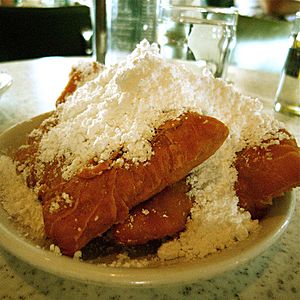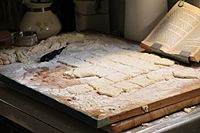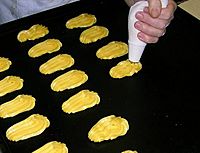Beignet facts for kids

Potato beignets from Haute-Savoie
|
|
| Type | Pastry |
|---|---|
| Place of origin | Ancient Rome |
| Main ingredients | Dough, powdered sugar |
| Variations | Sourdough |
A beignet (pronounced BEN-yay) is a tasty type of fritter. It is a pastry that has been deep-fried, meaning it's cooked in hot oil. Beignets are often made from a special kind of dough called pâte à choux (say: pat-ah-SHOO). But they can also be made from other doughs, like yeast dough.
Contents
What Are the Different Types of Beignets?
The word "beignet" can describe a few different fried pastries. In the United States, especially in New Orleans, a beignet usually means a deep-fried pastry made from choux pastry.
Yeast Dough Beignets
Beignets can also be made with yeast dough. These might be called boules de Berlin in French. This name refers to Berliner doughnuts. These doughnuts do not have a hole in the middle. They are often filled with fruit or jam.
Beignets in Other Places
- In Corsica, an island near France, beignets are made with chestnut flour. These are known as fritelli.
- In Canadian French, people sometimes call doughnuts either beigne or beignet.
Beignets in New Orleans

Beignets are very famous in New Orleans, Louisiana. They are often eaten for breakfast. People usually serve them with a lot of powdered sugar on top. For the best taste, beignets are made and eaten right away. This way, they are fresh and hot.
Fried dough can be found in many cultures around the world. However, the word "beignet" comes from France. French colonists brought beignets to New Orleans in the 1700s. They also came with the Acadians, who settled in Louisiana. Beignets quickly became a big part of Creole cooking in homes. Sometimes, people add fruits like banana or plantain to them. These fruits are popular in New Orleans because it is a port city. Berries can also be added.
How to Make Beignets
Making beignets involves a few simple steps. Here are some common ingredients used:
- Lukewarm water
- Granulated sugar
- Evaporated milk
- Bread flour
- Shortening
- Oil or lard (for deep-frying)
- Confectioners' sugar (for dusting on top)
See also
 In Spanish: Beignet para niños
In Spanish: Beignet para niños



